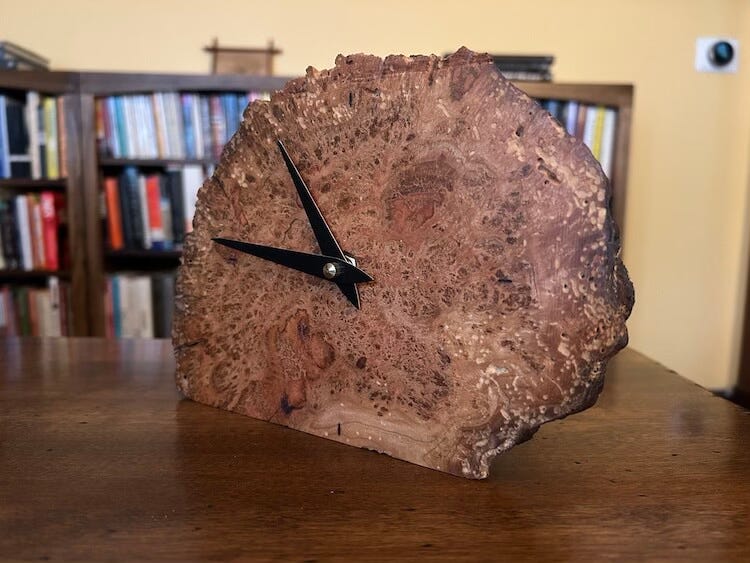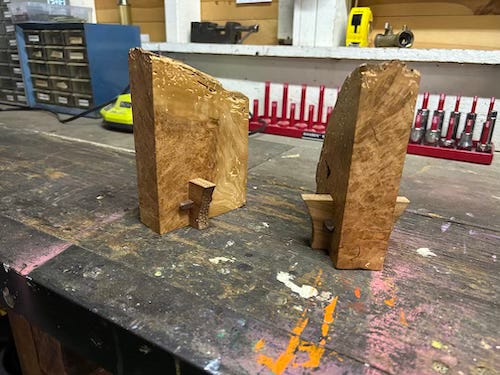Greetings! The weather is cool and rainy here, which our family enjoys, though it does mean the dog brings the smell of wet fur into the house on a regular basis.
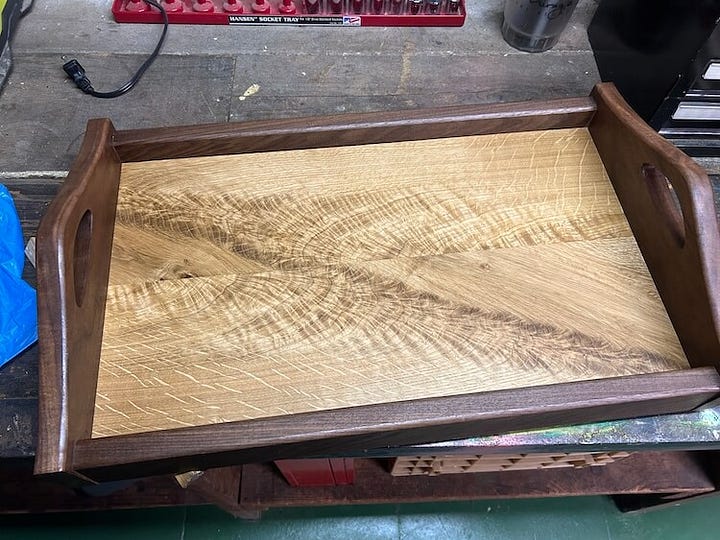

Dad helped me plane the crazy feathered green ash wood for this tray. I really love the figure, and wanted to highlight it by putting into the dark frame of black walnut. The backdrop for these photos is Josiah’s small workbench, which he has in one corner of our basement. It is dangerously easy to continue encroaching on every available horizontal surface and I’ve found Josiah’s bench to be ideal for putting finish on.
Today’s essay is below. I hope the next couple of weeks find you well. ❤️
The last few weeks have been a woodworking retreat of sorts. Sorting through the scrap pile, discovering intriguing pieces with potential, working on inlay, and gluing small wood strips to prepare blank boards for burning designs.
The stakes are low, the opportunity to learn is high, and the moments for creative exploration are plentiful. My work is big and small: large cabinetry and handheld decor. I believe I’ve mentioned how the former requires meticulous planning, detailed sketches, and carefully prepared lumber to be assembled into a functional structure.
Decor, however, follows a different creative process. It requires a leap of faith—trusting that my intuitive approach will yield something desirable. And it’s this type of work that feels like a break, offering a liberating chance to play and experience creativity without strict constraints.
Yet, I'd be dishonest if I didn't acknowledge an underlying tension: the gremlins of doubt that lurk in this creative space, whispering uncertainties with each repetitive thought.
A couple of years ago, Dad and I cut up a cherry burl and left it in the back of the shop to dry. Last week, we took that small burl and cut it into slices about two inches thick. The wood quality wasn't great; it had many tiny holes pockmarked around the edges from where critters had eaten into it. Dad said if we came across any bugs, we'd have to burn the wood to prevent introducing them into anyone's home. Fortunately, there were none to be found, and the grain itself was quite lovely—typical of burls, cellular blooms radiating around each other.
I brought the little slices home, and made a prototype clock from one. Upon completion of that small project, Josiah, the long-standing adult in our relationship, reminded me that prototypes are the province of our family. It’s now sitting on the railing in our dining room.
I didn’t have anymore clock hardware and wasn’t quite sure what to make with the other sliver. The fragment sparked an idea of bookends, though I worried its two-inch width would be wobbly. I cut it in half, mindful of its unpredictable grain—burls can be devilish, chipping out or binding against cutting tools—and then rooted around in my shop for some small blocks of cherry to use as stabilizing feet on the bookends.
The blocks next to the burls looked like geometric interlopers—serious, 90-degree angles, sharp edges. Like the burl's sensuous curves, its supporting foot needed to curve into the world, not hold it at bay. So I cut matching arcs along its sides and created tiny slots for black walnut pins to hold the feet tight to the burl.
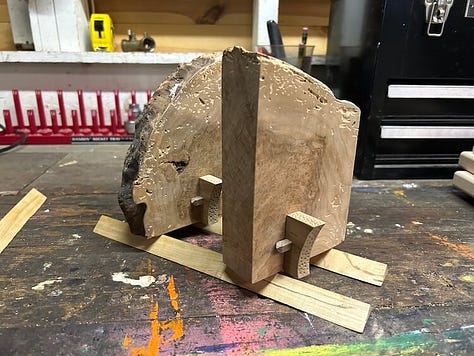
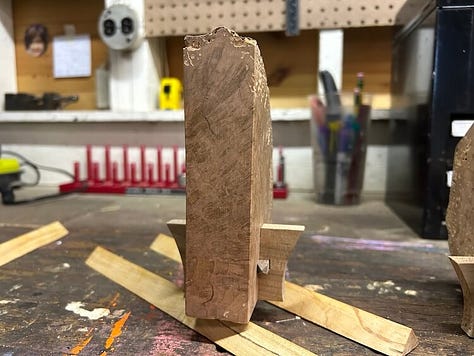
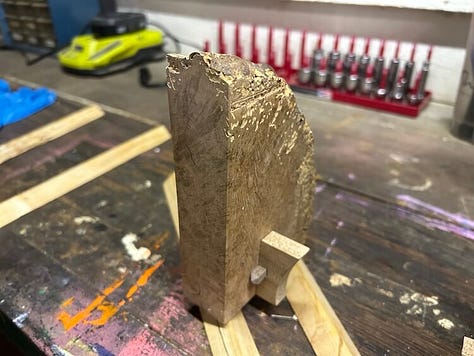
That could’ve been the end. But the feet still looked off. The burl's topography—its bumpy landscape, its dancing curlicue grain—needed a better partner. A conversation ensued between me and the block cutoffs as I attempted to figure out what was missing. I tried burning patterns into the end and edge grain. Cutting into it with a variety of small chisels. None of it worked, but those pieces made lovely kindling during the weekend’s outdoor fire pit.
I closed up shop for the day, trusting that when I returned the next morning, the way to proceed would become clear. And it did. The next morning I used a rotary tool with carving bit and scored the top and edges. Simple and what I was looking for.
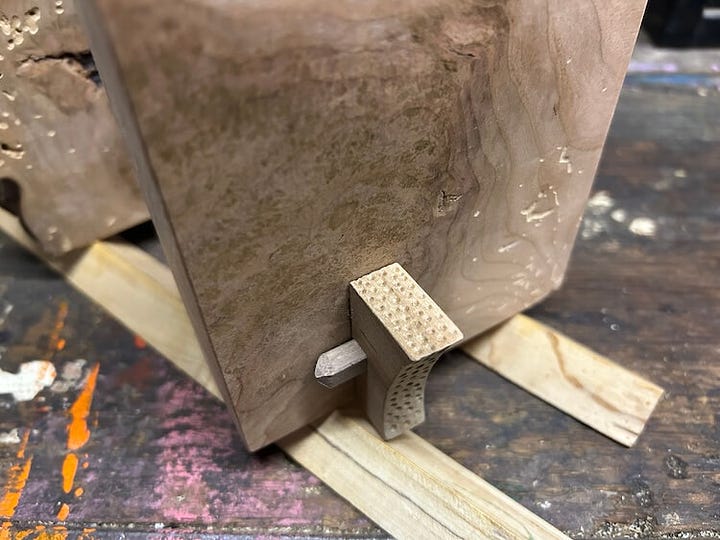
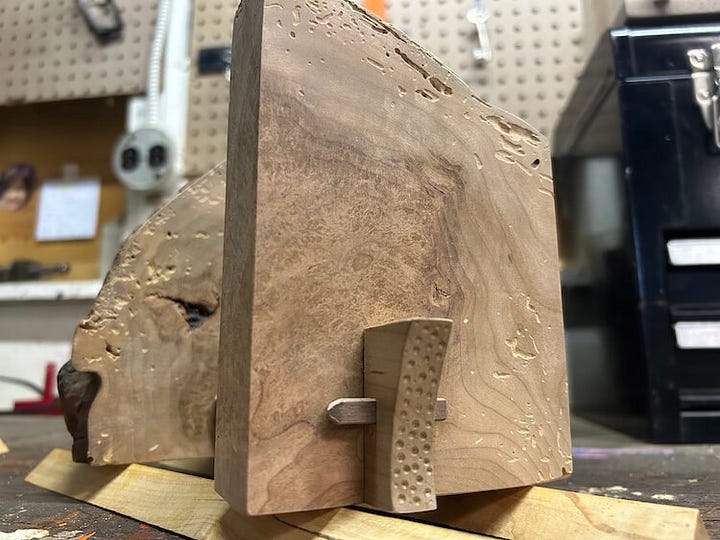
Sometimes I think that’s what mastery of any craft actually is: not simply developing skills or gaining efficacy with whatever tools you’re using, but building up trust in yourself to know you can create the thing loosely and ever so hopefully held in your mind.
Prior to picking up the burl, I inhabited a landscape of potential—fuzzy shapes far on the horizon, still undefined. Even after committing to bookends, the final form remained amorphous. Each movement became an act of faith, of trust.
Perhaps because this landscape is so spacious, open, ephemeral, it is also where the gremlins gather. They are shapeshifters: echoes of past criticisms, other people’s expectations and judgements, spectral voices questioning your worth.
My main demon is the Why Gremlin—a bloated creature with one insistent interrogation: What is the point? Why persist? Is this the most meaningful thing you can do with your one life?
This guy knows where it hurts. Keeps a tally handy of how many times I’ve been told I overthink things and don’t think conscientiously enough. Runs me down. Reminds me that I need to be more confident in myself and that my way of being in the world is wrong.
Not terribly clever, nor good companionship, but a constant anyway.
Mastery, then, is not defeating these gremlins, it’s not even about silencing them (the more I try, the louder they howl), but about continuing to find my footing on the open landscape of that creative plain, even as the gremlins vie for my attention.
Mastery is learning how to not get in your own way. This can only be accomplished by accepting the gremlins as a fact of the process and getting to work anyway.





